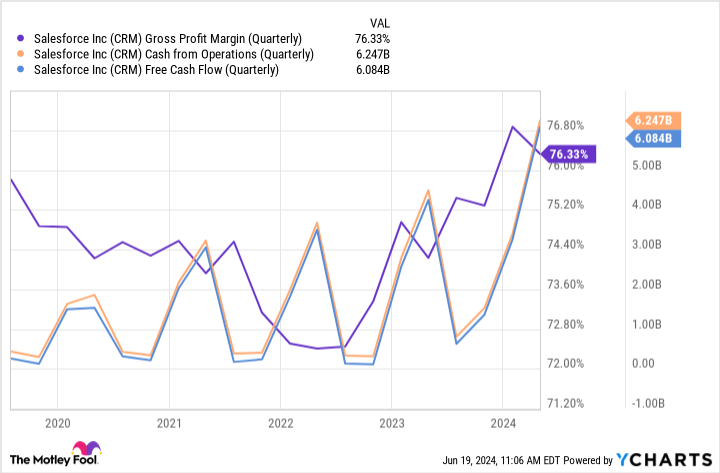Artificial intelligence (AI) is the hottest theme in the technology realm right now. Indeed, megacap behemoths such as the “Magnificent Seven” are innovating at light-speed paces and investors can’t seem to get enough.
Beyond the biggest of the big tech players, numerous other enterprise software businesses have garnered Wall Street’s interest. Salesforce.com (NYSE: CRM) makes for one of the most interesting case studies as it relates to AI software.
With shares down roughly 12% year to date, Salesforce is drastically underperforming the Nasdaq Composite and S&P 500 indexes. Nevertheless, I see the company as a compelling investment opportunity, and I think shares are dirt cheap.
Scrutiny at Salesforce
Since 2018, Salesforce has spent nearly $50 billion to acquire three companies: MuleSoft, Tableau, and Slack.
To put this into perspective, Salesforce has generated only about $35.7 billion in revenue over the last 12 months. Considering that the three companies mentioned above have been part of the Salesforce ecosystem for several years now, it’s reasonable to conclude that the company may not be monetizing these assets as well as it could.
Moreover, given that artificial intelligence (AI) is the bedrock of the tech realm right now, investors appear to be uninspired by Salesforce’s paltry 11% revenue growth for its most recent fiscal quarter, which ended April 30.
On the surface, I’d say these concerns are valid. However, a deeper dive into the company’s latest earnings report sheds light on where Salesforce is witnessing impressive growth, and more importantly, how the operating efficiencies management has been pursuing are finally beginning to materialize.
Looking beyond revenue
Although the headline numbers on an income statement are useful for getting a sense of a company’s sales and profitability profiles, getting too caught up in these metrics alone can cause investors to miss the bigger picture.
The chart below features some other financial indicators that I’d encourage investors to analyze.

There are a couple of important themes to discuss here. First, Salesforce’s gross margin profile has improved dramatically over the last few years. So too has its cash flow situation.
This dynamic is very much by design. “We have more than tripled the cash we generated just four years ago,” Chief Financial Officer Amy Weaver said during the company’s most recent earnings call. In essence, even though Salesforce is only growing revenue by 11% annually, its free cash flow is rising by more than 40% annually.
To me, that robust growth in cash flow generation is far more important than trends in the top line.
Salesforce stock is a bargain among AI software opportunities
The chart below benchmarks Salesforce against a cohort of other leading enterprise AI software businesses on a price-to-free-cash-flow (P/FCF) basis.

Among these peers, Salesforce has the lowest P/FCF multiple — and it isn’t even close. I think investors are missing the forest for the trees when it comes to Salesforce and its potential as a leading AI opportunity.
It’s important to keep in mind that revenue is going to ebb and flow from quarter to quarter. Furthermore, on a macroeconomic level, the past couple of years featured first a sharp spike in inflation and then, even after it retreated, the lingering impacts of that surge. Considering that, it’s natural that businesses of all sizes have reined in spending and are operating under tighter budgets — a dynamic that will directly impact Salesforce’s ability to increase its revenues.
Moreover, I’d be remiss not to note that the company’s integration and analytics business — which includes Tableau and MuleSoft — was Salesforce’s top-performing operation during the first quarter, growing 25% year over year.
I think Wall Street was correct to start demanding more growth from Salesforce’s acquired assets. But as the AI narrative continues to unfold, I think the company is merely scratching the surface of its potential.
As Tableau, MuleSoft, and other services begin to comprise a more meaningful share of Salesforce’s overall business, I think accelerating revenue prospects are very much in store. Those should contribute even more to the company’s improving profit margin and cash flow positions.
I think investing in Salesforce is a no-brainer right now. With the stock trading at such a noticeable discount to its peers and underperforming the broader market, I think Salesforce looks dirt cheap.
Should you invest $1,000 in Salesforce right now?
Before you buy stock in Salesforce, consider this:
The Motley Fool Stock Advisor analyst team just identified what they believe are the 10 best stocks for investors to buy now… and Salesforce wasn’t one of them. The 10 stocks that made the cut could produce monster returns in the coming years.
Consider when Nvidia made this list on April 15, 2005… if you invested $1,000 at the time of our recommendation, you’d have $775,568!*
Stock Advisor provides investors with an easy-to-follow blueprint for success, including guidance on building a portfolio, regular updates from analysts, and two new stock picks each month. The Stock Advisor service has more than quadrupled the return of S&P 500 since 2002*.
See the 10 stocks »
*Stock Advisor returns as of June 10, 2024
Suzanne Frey, an executive at Alphabet, is a member of The Motley Fool’s board of directors. Adam Spatacco has positions in Alphabet and Microsoft. The Motley Fool has positions in and recommends Alphabet, Microsoft, Oracle, Salesforce, ServiceNow, and Snowflake. The Motley Fool recommends the following options: long January 2026 $395 calls on Microsoft and short January 2026 $405 calls on Microsoft. The Motley Fool has a disclosure policy.
1 Ridiculously Cheap Artificial Intelligence (AI) Growth Stock to Buy Hand Over Fist Right Now was originally published by The Motley Fool
Credit: Source link




